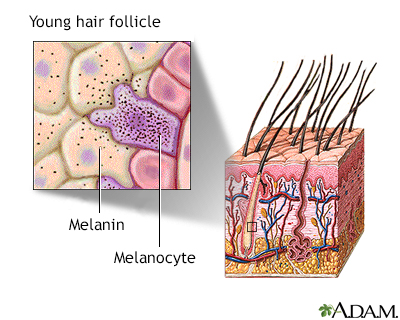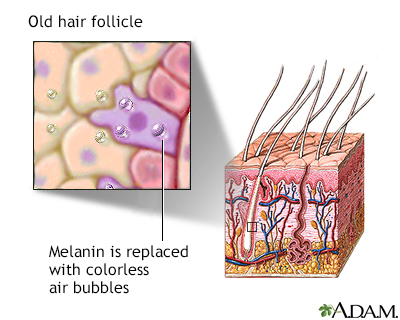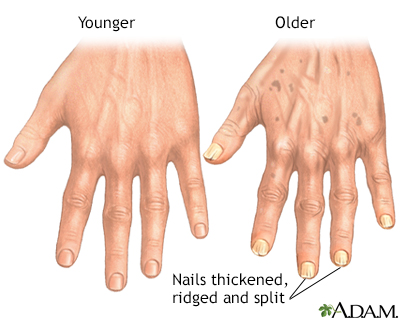Aging changes in hair and nails
Images



I Would Like to Learn About:
Information
Your hair and nails help protect your body. They also keep the temperature of your body steady. As you age, your hair and nails begin to change.
HAIR CHANGES AND THEIR EFFECTS
Hair color change. This is one of the clearest signs of aging. Hair color is due to a pigment called melanin, which hair follicles produce. Hair follicles are structures in the skin that make and grow hair. With aging, the follicles make less melanin, and this causes gray hair. Graying often begins in the 30s.
Scalp hair often starts graying at the temples and extends to the top of the scalp. Hair color becomes lighter, eventually turning white.
Body and facial hair also turn gray, but most often, this happens later than scalp hair. Hair in the armpit, chest, and pubic area may gray less or not at all.
Graying is largely determined by your genes. Gray hair tends to occur earlier in white people and later in Asians. Nutritional supplements, vitamins, and other products will not stop or decrease the rate of graying.
Hair thickness change. Hair is made of many protein strands. A single hair has a normal life between 2 and 7 years. That hair then falls out and is replaced with a new hair. How much hair you have on your body and head is also determined by your genes.
Nearly everyone has some hair loss with aging. The rate of hair growth also slows.
Hair strands become smaller and have less pigment. So the thick, coarse hair of a young adult eventually becomes thin, fine, light-colored hair. Many hair follicles stop producing new hairs.
Men may start showing signs of baldness by the time they are 30 years old. Many men are nearly bald by age 60. A type of baldness related to the normal function of the male hormone testosterone is called male-pattern baldness. Hair loss may be at the temples or at the top of the head.
Women can develop a similar type of baldness as they age. This is called female-pattern baldness. Hair becomes less dense and the scalp may become visible.
As you age, your body and face also lose hair. Women's remaining facial hair may get coarser, most often on the chin and around the lips. Men may grow longer and coarser eyebrow, ear, and nose hair.
Contact your health care provider if you have sudden hair loss. This can be a symptom of a health problem.
NAIL CHANGES AND THEIR EFFECTS
Your nails also change with age. They grow more slowly and may become dull and brittle. They may also become yellowed and opaque.
Nails, particularly toenails, may become hard and thick. Ingrown toenails may be more common. The tips of the fingernails may break.
Lengthwise ridges may develop in the fingernails and toenails.
Check with your provider if your nails develop pits, ridges, lines, changes in shape, or other changes. These can be related to iron deficiency, kidney disease, and nutritional deficiencies.
OTHER CHANGES
As you grow older, you will have other changes, including:
References
Ball JW, Dains JE, Flynn JA, Solomon BS, Stewart RW. Skin, hair, and nails. In: Ball JW, Dains JE, Flynn JA, Solomon BS, Stewart RW, eds. Siedel's Guide to Physical Examination. 10th ed. St Louis, MO: Elsevier; 2023:chap 9.
Tosti A. Diseases of hair and nails. In: Goldman L, Schafer AI, eds. Goldman-Cecil Medicine. 26th ed. Philadelphia, PA: Elsevier; 2020:chap 413.
Walston JD. Common clinical sequelae of aging. In: Goldman L, Schafer AI, eds. Goldman-Cecil Medicine. 26th ed. Philadelphia, PA: Elsevier; 2020:chap 22.
BACK TO TOPReview Date: 7/21/2022
Reviewed By: Frank D. Brodkey, MD, FCCM, Associate Professor, Section of Pulmonary and Critical Care Medicine, University of Wisconsin School of Medicine and Public Health, Madison, WI. Also reviewed by David C. Dugdale, MD, Medical Director, Brenda Conaway, Editorial Director, and the A.D.A.M. Editorial team.

Health Content Provider
06/01/2025
|
A.D.A.M., Inc. is accredited by URAC, for Health Content Provider (www.urac.org). URAC's accreditation program is an independent audit to verify that A.D.A.M. follows rigorous standards of quality and accountability. A.D.A.M. is among the first to achieve this important distinction for online health information and services. Learn more about A.D.A.M.'s editorial policy, editorial process and privacy policy. A.D.A.M. is also a founding member of Hi-Ethics. This site complied with the HONcode standard for trustworthy health information from 1995 to 2022, after which HON (Health On the Net, a not-for-profit organization that promoted transparent and reliable health information online) was discontinued. |
The information provided herein should not be used during any medical emergency or for the diagnosis or treatment of any medical condition. A licensed medical professional should be consulted for diagnosis and treatment of any and all medical conditions. Links to other sites are provided for information only -- they do not constitute endorsements of those other sites. © 1997- 2024 A.D.A.M., a business unit of Ebix, Inc. Any duplication or distribution of the information contained herein is strictly prohibited.
